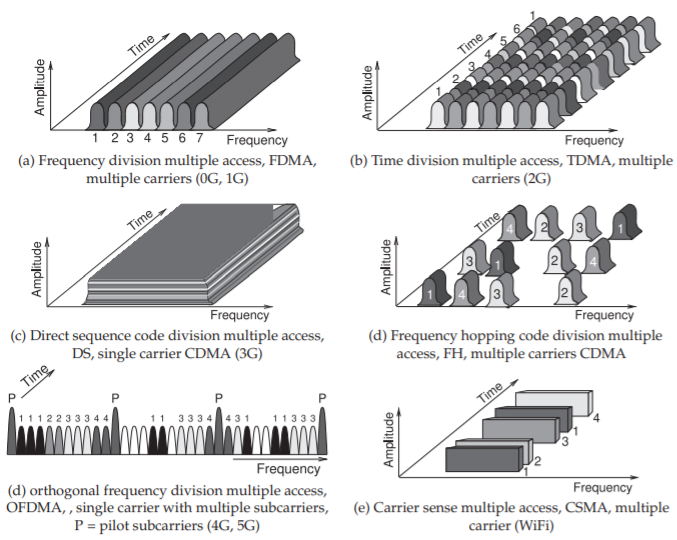5.4: Multiple Access Schemes
- Page ID
- 41218
Many schemes have been developed to enable multiple users to share a frequency band. The simplest scheme requiring the least sophistication in channel management is the frequency division multiple access (FDMA) scheme, shown in Figure \(\PageIndex{1}\)(a), where the numerals indicate a particular user. In FDMA the available spectrum is divided by frequency, with each user assigned a narrow frequency band that is kept for the duration of a call. This can be conveniently implemented in analog radio. In duplex operation a frequency channel is assigned for the uplink as well as the downlink. An example of where FDMA is used is AMPS, where \(30\text{ kHz}\) is assigned to each channel. Clearly this is wasteful of spectrum, as not all of the band is used continuously.
In the first digital access technique, time division multiple access (TDMA), shown in Figure \(\PageIndex{4}\)(b), a bitstream is divided among a few users using the same physical channel. In the GSM mobile phone system,\(^{1}\) a physical channel is divided into eight time slots and a user is allocated to each so that eight users can be supported in each physical channel. Thus the logical channels are divided in both frequency and time. In a TDMA system, the basestation transmits a continuous stream of data containing frames of time slots for multiple users. The mobile unit listens to this continuous stream, extracting and processing only the time slots assigned to it. On the reverse transmission, the mobile unit transmits to the basestation in bursts only in its assigned time slots. This is yet another complication to the RF design of TDMA systems. The RF circuitry operates in a burst mode with constraints on settling time. One of the advantages of GSM is that multiple slots can be assigned to the same user to support high data rates and time slots can be skipped.
Another technique that can be used in digital radio is spread spectrum (SS [12]), the invention of which is attributed to Hedwig Kiesler Markey\(^{2}\). Most of the development of spread spectrum was secret up until the mid-1970s. There are two main types of spread-spectrum techniques used in multiuser communication: direct sequence, and frequency hopping. It is both an access technique and a way to secure communications. Direct sequence code division multiple access (DS-CDMA)\(^{3}\) is shown in Figure \(\PageIndex{1}\)(c). DSCDMA mixes the baseband signal with a broadband spreading code signal to produce a broadband signal that is then used to modulate an RF signal [13, 14, 15]. This process is illustrated in Figure \(\PageIndex{2}\). The rate of the spreading code is referred to as the chip rate rather than the bit rate, which is reserved for the rate of the information-bearing signal. A unique code is used to

Figure \(\PageIndex{1}\): Multiple access schemes for supporting multiple users with each user indicated by a numeral except for (b), TDMA, where the numerals indicate time slots.

Figure \(\PageIndex{2}\): Block schematic of the operation of a CDMAOne spreadspectrum radio.

Figure \(\PageIndex{3}\): Basis of multiuser spread-spectrum communication.
“scramble” the original baseband signal, and the original signal can only be recovered using that particular code. The system can support many users, with each user assigned a unique code, hence the term code division multiple access (CDMA). Another interpretation of the DS-CDMA process is shown in Figure \(\PageIndex{3}\)(a). One of the unique characteristics is that different users are using the same frequency band at the same time. CDMA is used in the 3G wideband CDMA (WCDMA) system.
Another form of CDMA access is the frequency-hopping CDMA scheme (FH-CDMA) shown in Figures \(\PageIndex{1}\)(d) and \(\PageIndex{3}\)(b). This scheme uses frequency-hopping spread spectrum (FHSS) to separate users. For one particular user, a code is used to determine the hopping sequence and hops can occur faster than the data rate. The signal can only be reassembled at the receiver if the hopping code is known. FH-CDMA is useful in unregulated environments, such as an ad hoc radio network, where it is not possible to coordinate multiple users. In this case, two users can transmit information in the same frequency band at the same time with error correction for occasional errors. FH-CDMA is commonly used in radios for emergency workers and by the military.
Another multiple access scheme is carrier-sense multiple access (CSMA), which is used in the WiFi system (IEEE 802.11). The access scheme is illustrated in Figure \(\PageIndex{1}\)(e). This scheme is also used in hostile environments where various radios cannot be well coordinated. In CSMA, users transmit at different times, but without coordination. A terminal unit listens to the channel and transmits a data packet when it is free. Collisions are unavoidable and data are lost, requiring re-transmission of data, but the terminals use a random delay before re-transmitting data. In the case of WiFi there are several channels and if collisions are excessive another channel can be selected either as the preferred start-up channel or in evolved systems under central unit control.
Orthogonal frequency division multiple access (OFDMA) is used in worldwide interoperability for microwave access (WiMAX) and in 4G and 5G cellular radio. It overcomes many of the performance limitations encountered with CSMA as assignment of effective channels is used. OFDMA builds on orthogonal frequency division multiplexing (OFDM) introduced in Section 5.10.2.
Footnotes
[1] GSM stands for the 2G Global System for Mobile Communications and was formerly known as Groupe Special Mobile. The system was deployed worldwide in 1991. An interesting footnote is that the GSM group began discussions leading to the system in 1982. By the mid-1980s there were many different versions of the GSM system in Europe. The European Union (EU) intervened and all member countries adopted a single standard.
[2] The 1940 invention is described in [12]. The patent described a frequency-hopping scheme to render radio-guided torpedoes immune from jamming using a piano roll to hop among \(88\) carrier frequencies.
[3] DS-CDMA is usually referred to as just CDMA.


